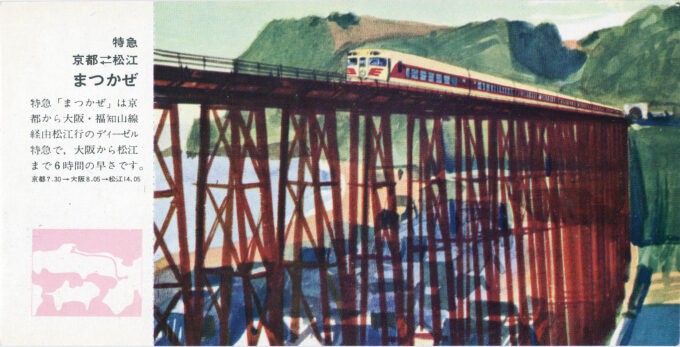
Kyoto-Matsue “Matsukaze” [“Pine Wind”] express advertising postcard, promoting the October 1, 1961 start of KiHa 82-series DMU (diesel multiple unit) service between Kyoto and Matsue on shared non-electrified track usually operated by two distinct lines of the then-JNR, with an map inset illustrating the route from Kyoto along the Sea of Japan coastline to Matsue. The DMU replaced steam locomotive service.
See also:
Lafcadio Hearn’s home, Matsue, Japan, c. 1950.
Yomega Island, Lake Shinji, Matsue, c. 1920.
J.N.R. Limited Express commemorative advertising postcard, October 1958.
“The “Matsukaze” express train was a popular limited express service that began operating between Kyoto and Matsue in the early 1960s. Launched in 1961, the “Matsukaze” [‘Pine Wind’] provided a convenient and scenic route through the Kansai and San’in regions, connecting Kyoto Station in Kyoto with Matsue Station in Shimane Prefecture on the coast of the Sea of Japan.
“The “Matsukaze” quickly became a favored option for passengers due to its comfortable, direct service and the scenic landscapes along the route. The train journey covered approximately 330 kilometers (205 miles), passing through notable locations such as Tottori and Himeji. In its early days, the train was known for traversing areas rich in historical and cultural sites, including ancient shrines, castles, and beautiful coastal views. The name “Matsukaze” itself evoked images of traditional Japanese poetry and nature, adding to the allure of the trip.
“The express train was initially powered by diesel multiple units (DMUs), as the San’in Main Line along which it traveled had not yet been fully electrified. These DMUs, especially the KiHa 80 series, were introduced to handle longer distances efficiently and were equipped with better seating, heating, and lighting than previous local trains, offering an upgraded experience for travelers. The train included both ordinary and first-class (Green Car) accommodations, providing a comfortable ride for those heading to Matsue for tourism or business.
“In 1962, the journey would have taken around 6 to 7 hours, making it a full-day trip that allowed passengers to enjoy the changing scenery across different regions of Japan. Matsue was a key destination, known for its historic Matsue Castle, Lake Shinji, the Lafcadio Hearn house, and the surrounding natural beauty, so the “Matsukaze” attracted tourists eager to explore the area, especially as domestic travel in Japan was becoming more popular.”
– Wikipedia

